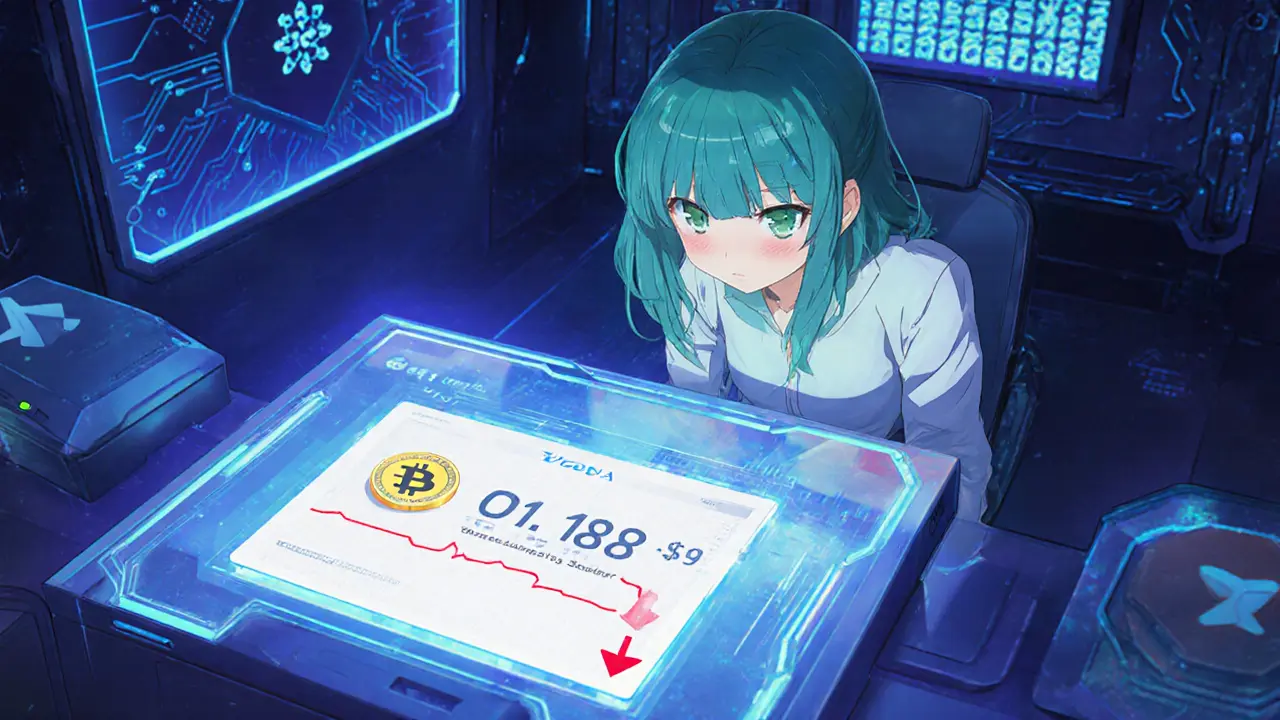DefiTuna (TUNA) Token Value Tracker
Current TUNA Price
24-hour volume: $938,380
Estimated Yield Calculator
TUNA Token Utility Breakdown
- Governance Rights Yes
- Staking Rewards Yes
- Fee Discounts Yes
- Total Supply Cap 1B TUNA
- Circulating Supply 35%
When you hear the name DefiTuna is a Solana‑based decentralized finance platform that lets users earn yields by supplying liquidity or lending assets. The hype around this project often boils down to three questions: what exactly is the platform, how does its native TUNA token function, and why should you care if you already trade on other blockchains? This article unpacks all of that, walks you through the tech that makes it tick, and shows the practical steps to get started - all without drowning you in jargon.
TL;DR
- DefiTuna is a Solana DeFi hub that combines leveraged liquidity provision with high‑yield lending.
- The native TUNA token powers governance, staking rewards, and fee distribution.
- Concentrated Liquidity Market Maker (CLMM) pools boost capital efficiency compared to regular AMMs.
- Security audits are completed, but smart‑contract bugs and leveraged‑position risks still exist.
- To join, connect a Solana wallet, grab some SOL for fees, and acquire TUNA on a supported exchange.
What is DefiTuna?
At its core, DefiTuna is a decentralized finance platform built on the high‑speed Solana blockchain. It aims to give liquidity providers (LPs) and lenders a single place to earn yields, either by depositing assets into concentrated liquidity pools or by lending to borrowers who need short‑term capital.
The platform launched in early 2025 and quickly hit a trading volume milestone of $3.8billion in just two months, indicating strong user interest. By leveraging Solana's sub‑second block times and near‑zero fees, DefiTuna can execute leveraged liquidity strategies that would be prohibitively expensive on Ethereum.
How does the TUNA token work?
The native cryptocurrency, TUNA, serves three main purposes:
- Governance: Token holders can vote on protocol upgrades, fee structures, and new pool launches.
- Staking rewards: By locking TUNA in the platform’s staking contract, users earn a share of the revenue generated from trading and lending fees.
- Fee discounts: Staked TUNA reduces transaction fees for liquidity provision and borrowing.
As of October2025, TUNA trades around $0.1188 with a 24‑hour volume of $938,380. Price‑prediction models vary, but most analysts keep a “Buy” rating, citing the token’s utility and the platform’s rapid growth.
Core technology: Concentrated Liquidity Market Maker (CLMM)
Traditional automated market makers (AMMs) spread liquidity across the entire price curve, which often wastes capital. DefiTuna’s Concentrated Liquidity Market Maker (CLMM) lets LPs allocate funds to a narrow price range, effectively “zooming in” on the most likely trading band.
Three key benefits arise:
- Higher capital efficiency: The same amount of capital can earn more fees because it’s concentrated where trades happen most.
- Leverage options: Users can take short, long, or pseudo‑delta‑neutral positions, magnifying potential returns (and risks).
- Dynamic APY: Yield rates update in real‑time based on pool utilization, giving LPs transparent insight into earnings.
The CLMM model is powered by smart contracts on Solana, which execute trades, calculate fees, and manage leveraged positions without a central intermediary.

Yield opportunities: Liquidity provision and lending
DefiTuna offers two primary revenue streams:
- Liquidity provision: Deposit SOL‑based assets into a CLMM pool, set your price range, and earn a cut of transaction fees plus any leveraged earnings.
- Lending: Supply assets to the lending module, where borrowers pay interest that’s split between lenders and the platform.
Both modules report live APY numbers on the dashboard. Early adopters have posted double‑digit yields, though exact percentages swing with market demand and pool size. Since the platform is built on Solana, transaction costs are typically a few cents, keeping net returns attractive even after fees.
Security and audits
Security is a top concern for any DeFi protocol. DefiTuna’s security audit has been completed by two reputable firms, with a public report confirming no critical vulnerabilities in the core contracts. The team also runs a bug‑bounty program with white‑hat researchers to catch any emerging issues.
That said, no platform is immune to risk. Leveraged liquidity positions can be liquidated if the price moves outside your set range, and smart‑contract bugs-however rare-could still arise. Users are encouraged to start small, monitor pool performance, and stay updated on audit releases.
Token economics & market data
The total supply of TUNA is capped at 1billion tokens, with roughly 35% circulating as of the latest snapshot. A portion of the supply is allocated to staking rewards, ecosystem growth, and the development fund. Revenue from trading fees (about 0.2% per swap) and lending interest is funneled back to TUNA stakers, creating a feedback loop that can boost token demand.
Price snapshots:
- Current price: $0.1188
- 24‑hour change: -9.32%
- 24‑hour volume: $938,380
- Projected 2029 average: $0.1019 (based on multiple forecast models)
While the token has faced short‑term price dips, analysts point to the platform’s growing TVL (total value locked) and expanding user base as long‑term support drivers.
Getting started: Wallets, acquiring TUNA, using the platform
Follow these steps to join DefiTuna:
- Download a Solana‑compatible wallet (Phantom, Solflare, or Backpack).
- Fund the wallet with a small amount of SOL to cover transaction fees (usually <$0.01 per action).
- Buy TUNA on a supported exchange such as Bitget or via a Solana DEX like Raydium.
- Connect your wallet to the DefiTuna web app by clicking the “Connect Wallet” button.
- Choose a pool, set your price range, and deposit assets. If you prefer passive income, stake your TUNA in the governance contract.
The platform’s UI is designed for beginners, with tooltips explaining each field. For deeper strategies-like leveraging short positions-watch the official YouTube tutorials or community guides on Reddit.
Risks and considerations
Before you dive in, keep these warnings in mind:
- Impermanent loss: Concentrated liquidity can cause larger losses if the market moves sharply away from your chosen range.
- Leverage liquidation: Leveraged pools automatically liquidate positions that breach margin thresholds, potentially wiping out capital.
- Regulatory uncertainty: DeFi protocols operate in a gray area in many jurisdictions; future regulations could affect token utility.
- Network stability: Solana occasionally experiences outages; downtime would pause all transactions on DefiTuna.
Mitigate these risks by diversifying across pools, using modest leverage, and staying informed about Solana network updates.

Frequently Asked Questions
What is the main advantage of DefiTuna’s CLMM over traditional AMMs?
CLMM lets liquidity providers concentrate their capital in a narrow price band, which increases fee earnings per dollar compared to spreading liquidity across the whole curve. This higher capital efficiency also enables leveraged positions that can amplify returns.
How can I earn rewards without providing liquidity?
Stake your TUNA tokens in the governance contract. Stakers receive a share of platform fees and a portion of the lending interest, generating passive income even if you don’t deposit into pools.
Is DefiTuna safe for a beginner?
The core contracts have passed two external audits, and the UI is beginner‑friendly. However, leveraged liquidity and impermanent loss are advanced concepts, so start with small, unleveraged positions and use the platform’s staking feature first.
Where can I buy TUNA?
TUNA is listed on several exchanges, including Bitget, KuCoin, and on Solana DEXs like Raydium and Orca. Transfer the tokens to your Solana wallet before connecting to DefiTuna.
What happens if Solana experiences an outage?
All on‑chain actions, including swaps, staking, and loan repayments, pause until the network resumes. Your assets remain in the contracts, but you won’t be able to move them until the blockchain is back online.


19 Responses
Look, everyone’s glued to the glossy numbers on Solana, but no one talks about how the network’s validators are practically run by a handful of whale‑level entities. The whole DeFi hype machine, including DefiTuna, is sitting on a fragile foundation that could crumble if those big players decide to pull the plug. It feels like a house of cards when the only thing holding it up is a few big stakeholders, and the token economics are just a smokescreen for that power concentration.
Keep an eye on the governance votes – they’re where the real control lies.
Wow, TUNA looks sooo cool!! 😍😍 I cant wait to try it out, but the price dip kinda bummed me 😢 hope it bounces back soon!
DefiTuna’s rise is the latest episode in the endless saga of DeFi hype, and the drama around its CLMM model reads like a thriller where the hero’s victory is always delayed by a new fee shock. The token’s volatility feels less like market dynamics and more like a plot twist designed to keep users on the edge of their seats, while the underlying risk of leveraged positions lurks like an unseen antagonist waiting to pounce. In short, the excitement is manufactured, and the real stakes are hidden behind glossy dashboards.
First, install a Solana‑compatible wallet such as Phantom or Solflare. Next, transfer a small amount of SOL to cover transaction fees; even 0.01 SOL is enough for most operations. Then, locate TUNA on a reputable exchange – for example, Orca or Raydium – and swap some SOL for TUNA. After acquiring the token, open the DefiTuna app, connect your wallet, and you’ll see the staking and liquidity provision tabs. Choose the pool that matches your risk tolerance, set a narrow price range if you prefer concentrated liquidity, and finally confirm the transaction. The platform will display your expected APY instantly, and you can begin earning rewards right away.
If you’re new to staking, start small and watch how the rewards auto‑compound each day. The more TUNA you lock, the lower your fee tier becomes, which means you keep a bigger slice of the platform’s earnings. Consistency beats trying to chase the highest APY for a short burst.
DefiTuna offers a simple way to dip your toes into Solana DeFi without getting lost in complex jargon. Just remember to keep some SOL handy for fees and watch the TVL numbers if you want a sense of the platform’s growth.
i think the token has potenial but yu should reseaarch before jumpig in the pool. risk is real.
When you first glance at DefiTuna’s dashboard, the vibrant charts and instantly updating APY numbers can feel like a kaleidoscope of opportunity, each swirl promising a new avenue for yield extraction that seems both tantalizing and bewildering in equal measure; however, beneath that dazzling surface lies a sophisticated set of mechanisms that demand a careful, methodical approach to truly harness their potential, especially for newcomers who might be tempted to chase the highest advertised returns without fully appreciating the intricacies of concentrated liquidity and the inherent risks of leverage that can, in a moment’s flash, flip a profitable position into a margin call; therefore, it is prudent to begin by allocating a modest portion of your portfolio to a single, well‑understood pool, meticulously setting the price range to mirror prevailing market trends while simultaneously monitoring the pool’s utilization metrics, because these data points serve as the pulse of the system, indicating when liquidity is being efficiently capitalized versus when it is idling and accruing unnecessary opportunity cost; as you gain confidence, you can gradually diversify across multiple pools, experiment with varying degrees of concentration, and even explore the lending module to supplement your earnings, all the while keeping a vigilant eye on transaction fees, which, while low on Solana, can still erode marginal gains if you are not judicious about the frequency of your interactions with the protocol.
The tokenomics of TUNA look polished on paper, but the reality is that a 35 % circulating supply still leaves a massive inflationary headroom that could dilute holders if the development fund continues to mint new tokens for incentives. Investors should treat the “governance” label with skepticism until concrete proposals actually materialize.
Everyone’s buzzing about the short‑term dip, yet I see that as a buying chance that most people overlook because they’re too busy fearing another crash; the platform’s growing TVL and active audit reports suggest a foundation that can sustain price recovery, so the current bearish sentiment may just be market noise.
Check the latest audit report before adding large sums; it’s the safest first step.
Oh great, another “high‑yield” farm on Solana-because we totally needed more ways to lose SOL while pretending we’re making money 😂💸. Just remember the fees add up faster than your patience.
Honestly, the whole DefiTuna thing feels like a recycled version of every other CLMM project-same UI, same promises, same hype; it's as if the developers took a template and slapped a new logo on it-no originality, no surprise-just more of the same, and yet people keep shouting about “innovation.”
In contemplating the essence of decentralized finance, one cannot help but reflect upon the paradox that DefiTuna embodies: a system designed to democratize wealth creation while simultaneously concentrating power within a token‑governed hierarchy that mirrors the very centralization it claims to escape; the CLMM mechanism, brilliant in its efficiency, also serves as a metaphor for the precarious balance between freedom and control, where the narrow price bands represent the narrow corridors of liberty that can be swiftly closed by market forces, leaving participants to question whether true autonomy is attainable within such engineered constraints; thus, the act of staking TUNA becomes a ritualistic acceptance of both risk and reward, an acknowledgment that the pursuit of yield is inextricably linked to the surrender of a portion of one's agency to algorithmic governance, a surrender that may either elevate the individual through collective prosperity or entrap them within a cycle of dependency on protocol updates and token price fluctuations.
DefiTuna looks slick, but don’t let the UI fool you-behind that smooth surface sits a lot of moving parts that can catch you off guard if you’re not paying attention.
All signs point to steady growth ahead.
If you think the current APYs are a joke, you’re missing the point-people actually earn real returns when they follow the protocol rules and stay disciplined.
When you’re first getting your feet wet, focus on securing a reliable wallet, maintaining a small SOL balance for fees, and diversifying between staking and liquidity pools to smooth out variance in rewards.
The whole DefiTuna hype feels like a theatrical performance where the actors are just shouting about “high yields” while the audience pretends to understand the script; each sentence about “concentrated liquidity” is delivered with the same monotone enthusiasm as a broken record; the token’s price chart is presented as a triumph, yet the underlying volatility whispers a cautionary tale; the platform’s marketing materials glide over the risk of leveraged positions like a dancer avoiding a stumbling step; I find it exhausting to watch yet another project promise “governance power” while the reality remains a handful of silent voters; the audits are praised as bulletproof shields, but history teaches us that no code is infallible; many users dive in with hopes of quick profits, only to discover that transaction fees, however low, can erode slim margins; the community forums are flooded with optimistic memes, which hardly substitute for sober analysis; in the end, the allure of APY numbers becomes a fleeting sparkle that fades against the backdrop of market cycles; the strategic advice offered is often generic, echoing the same boilerplate across countless DeFi posts; one could argue that the entire ecosystem is a carousel of recycled ideas, each iteration dressed in a fresh token logo; despite the polished UI, the user experience can feel like navigating a maze without a map; the token’s supply dynamics, with a large portion reserved for future incentives, raise concerns about future dilution; the governance process, while touted as democratic, often suffers from low participation, making decisions feel top‑down; finally, the long‑term viability of DefiTuna hinges on more than just yield-it requires sustainable adoption, robust risk management, and genuine community engagement, elements that remain uncertain at best.